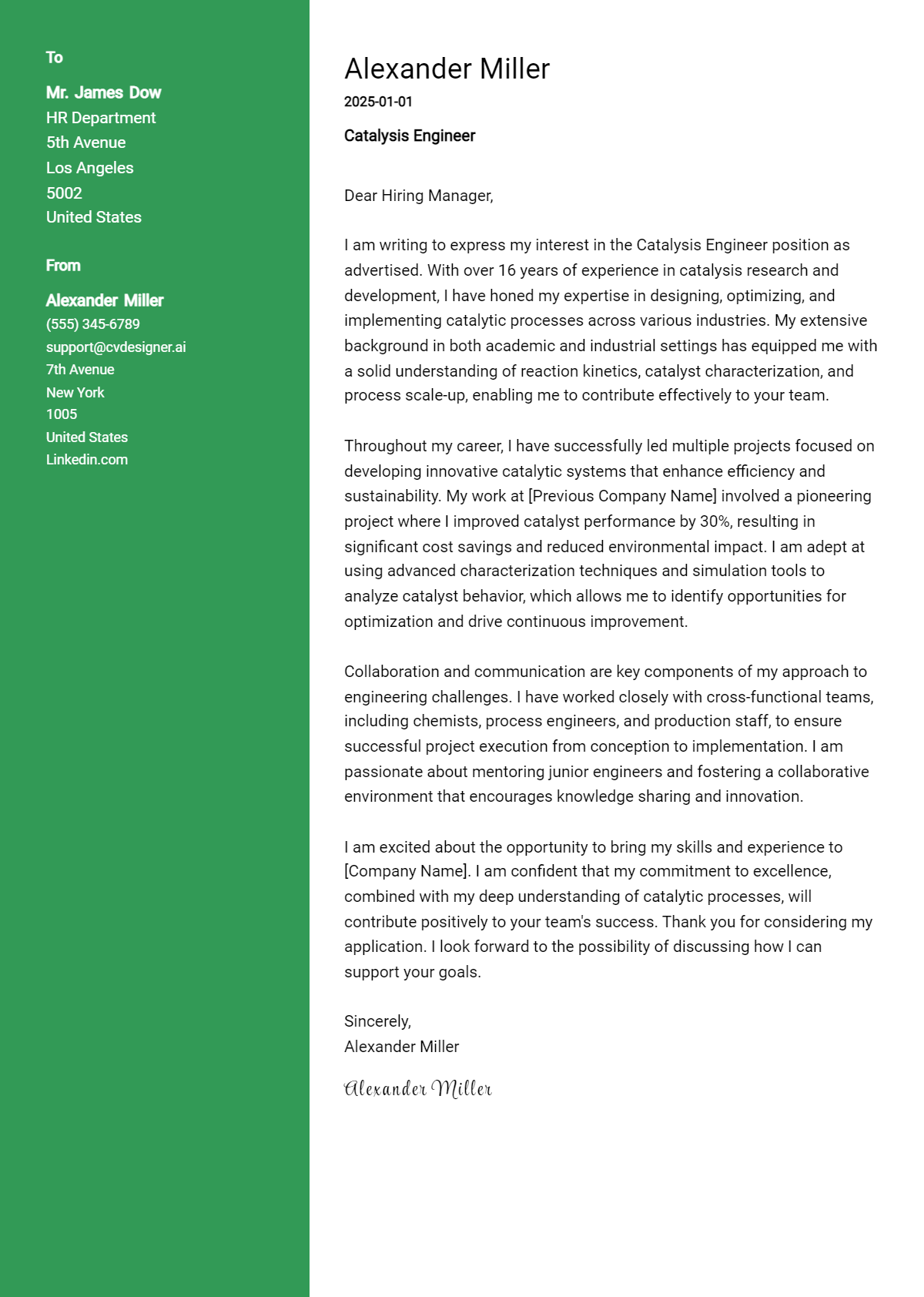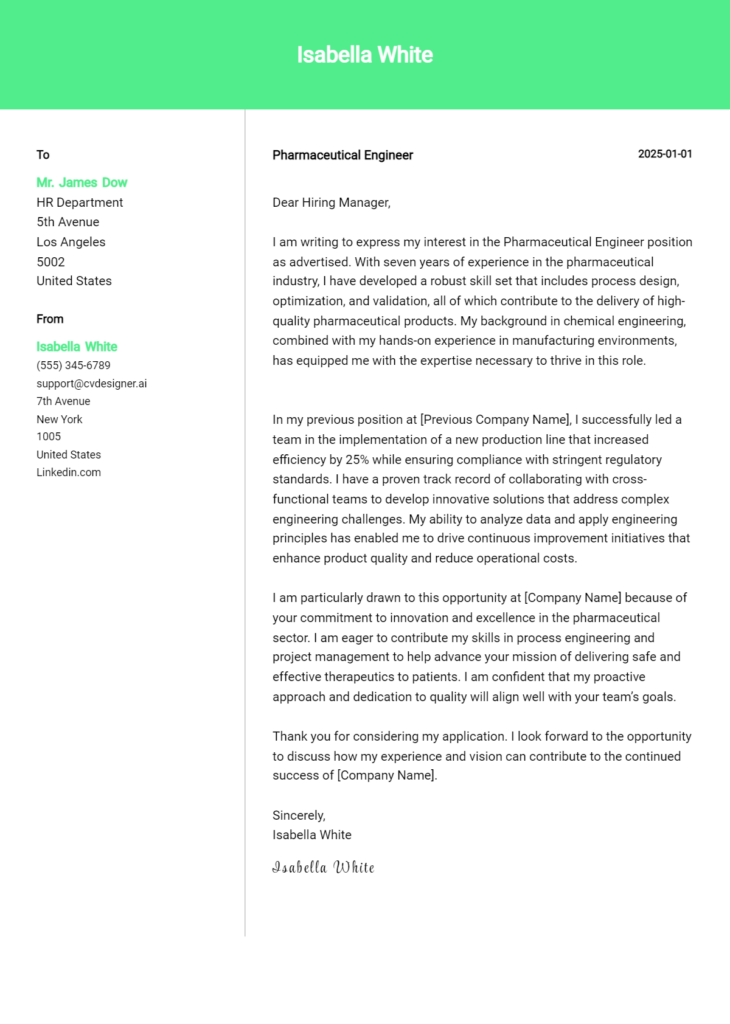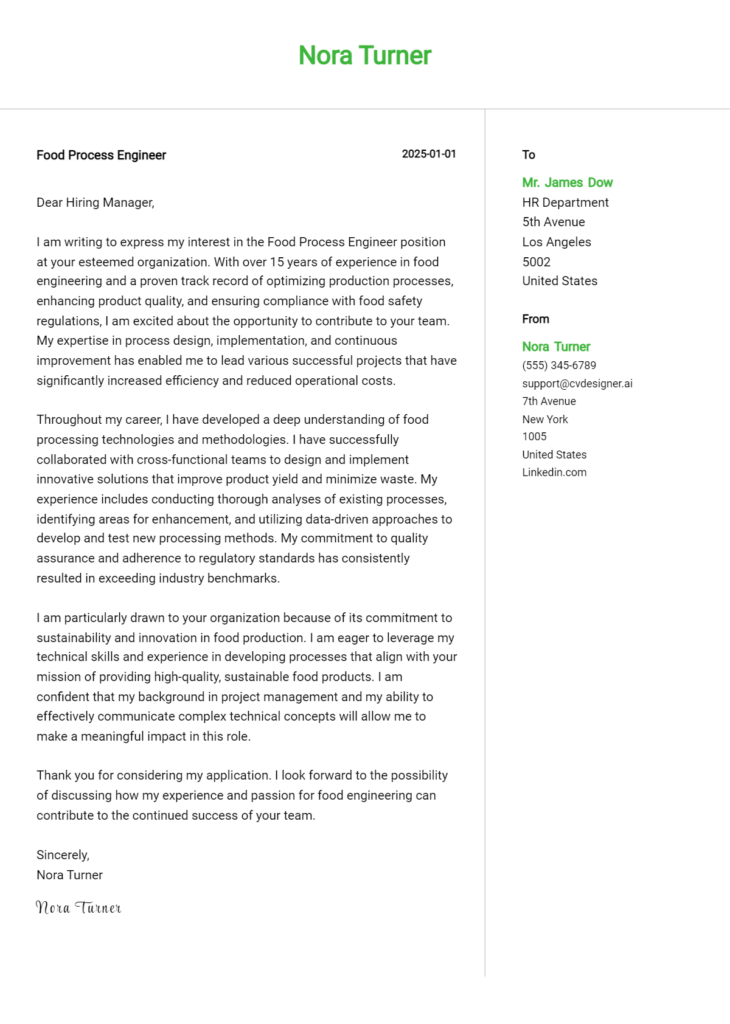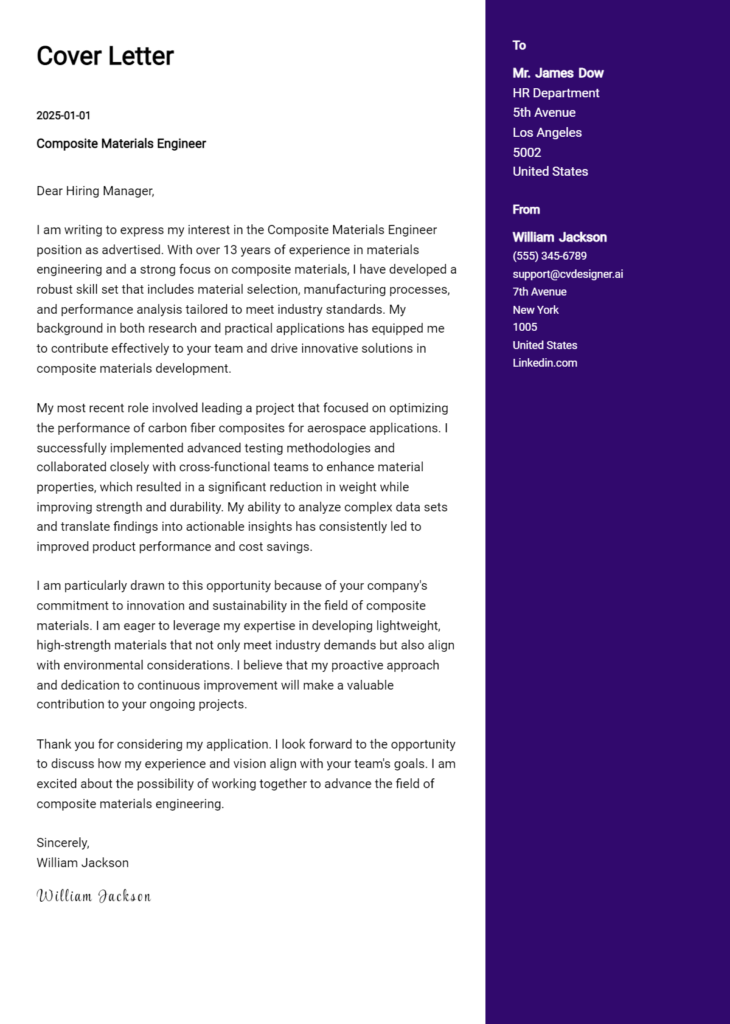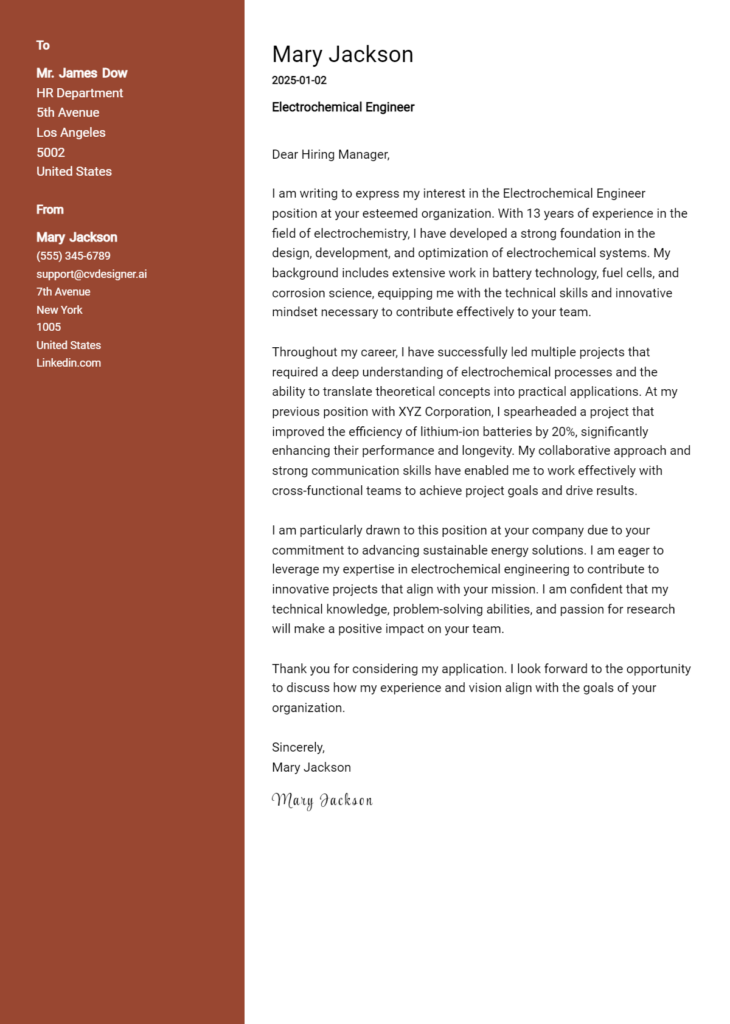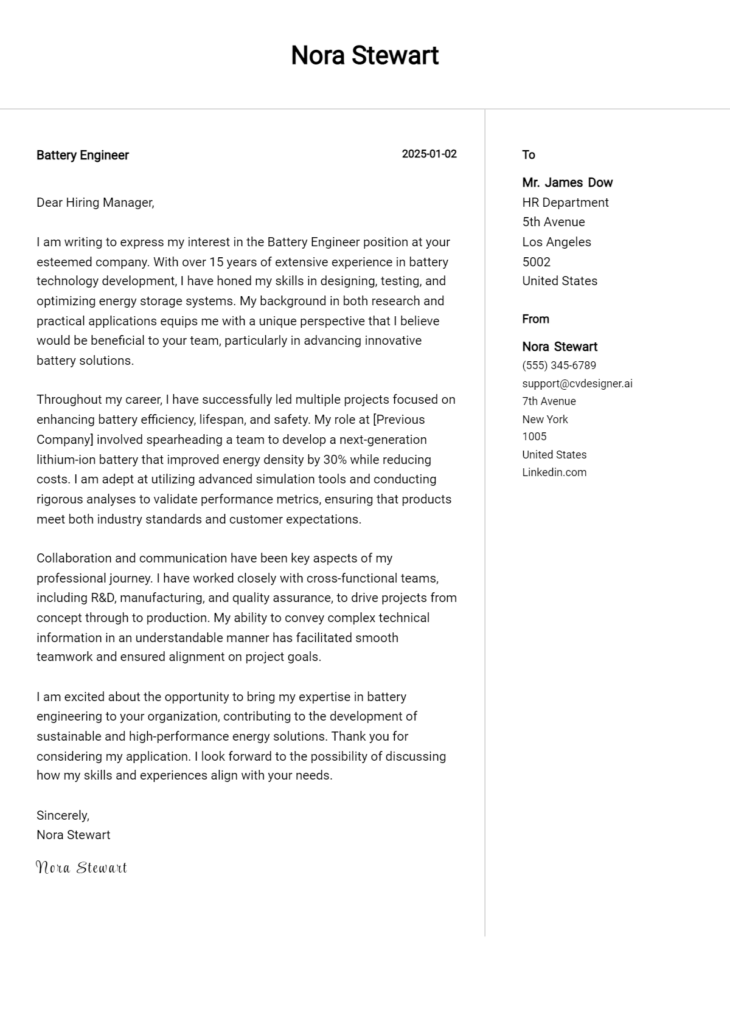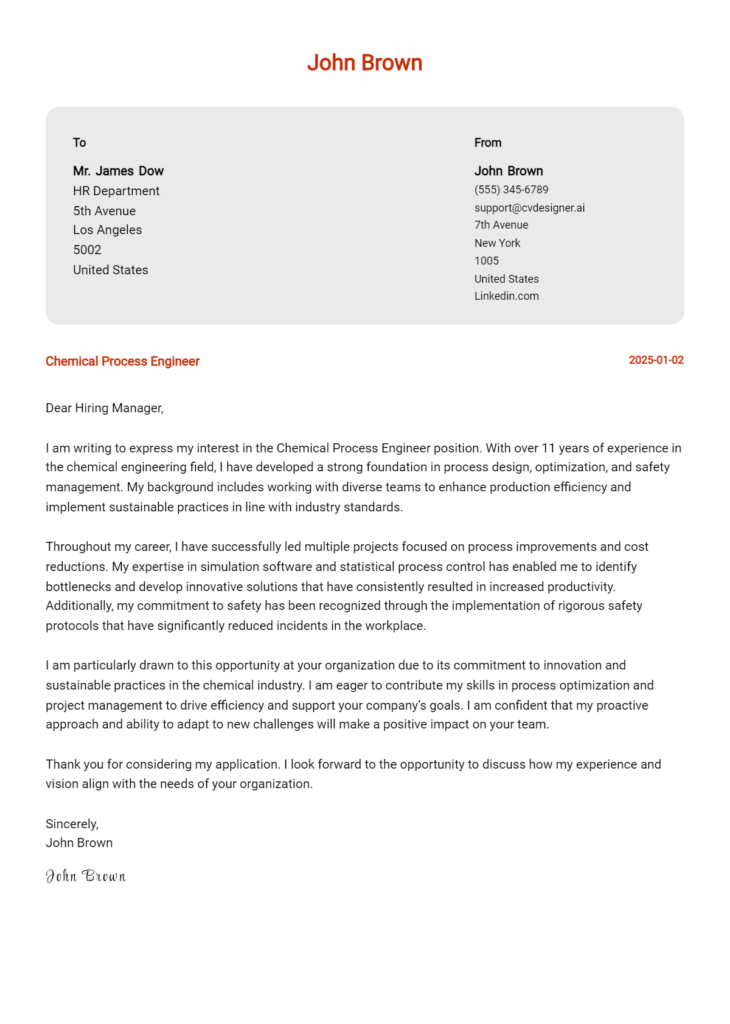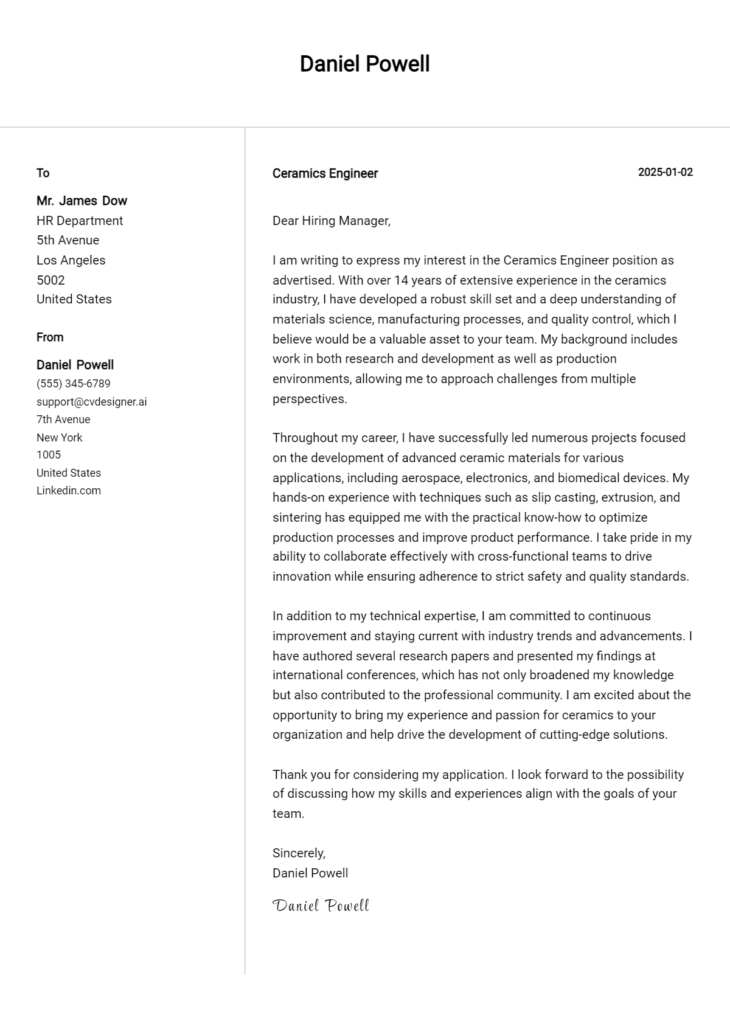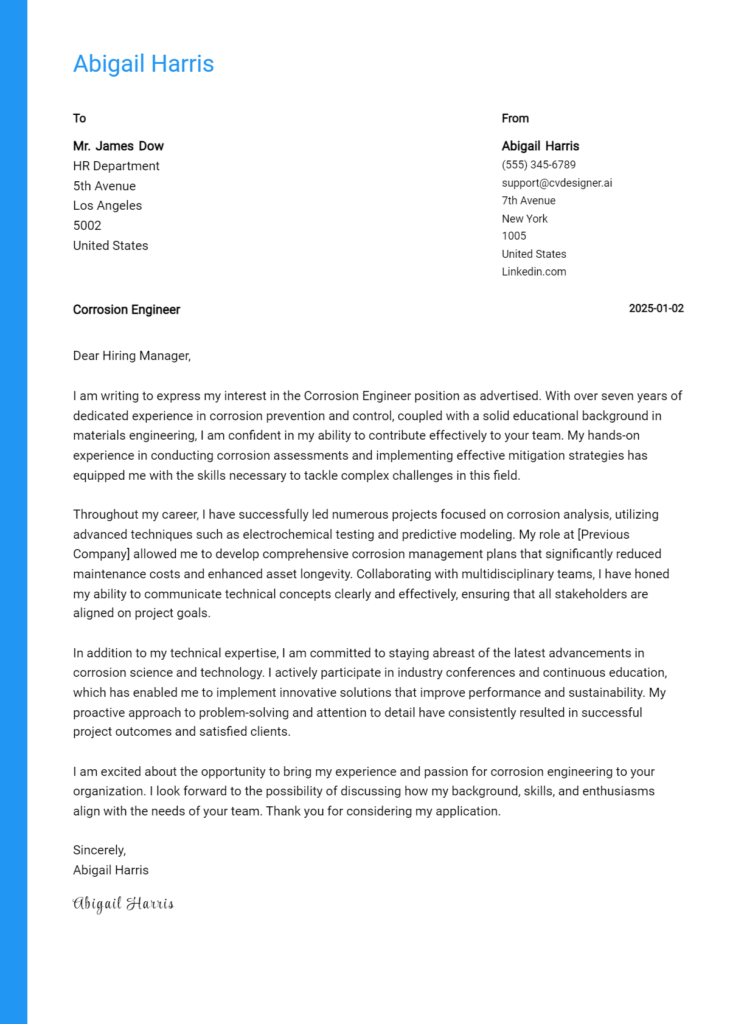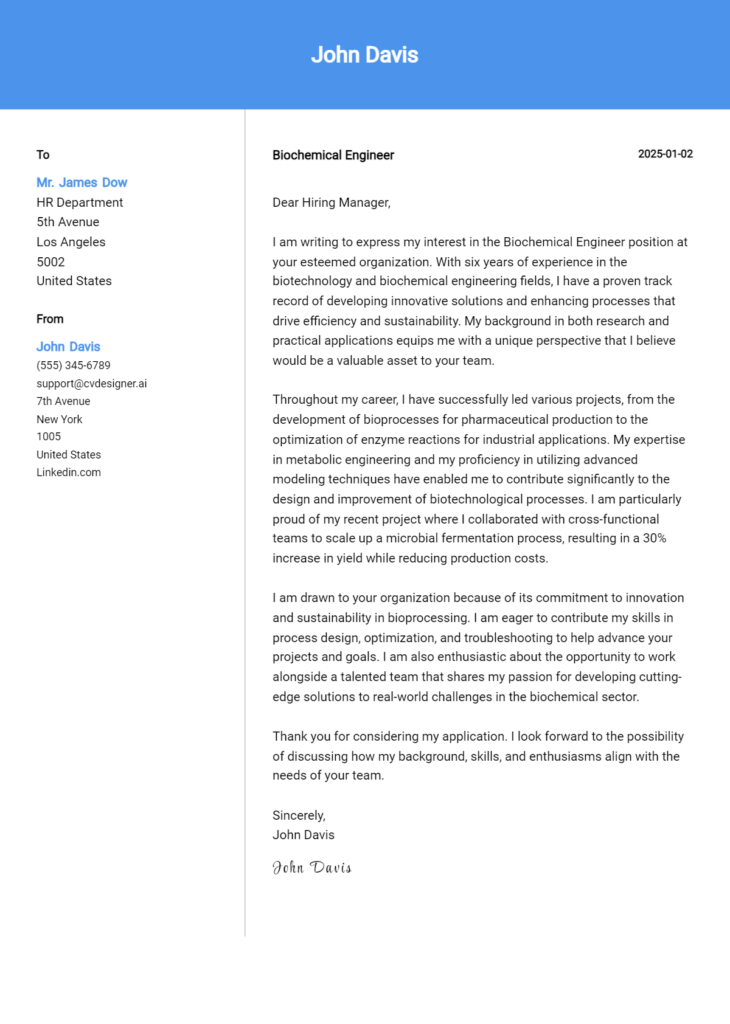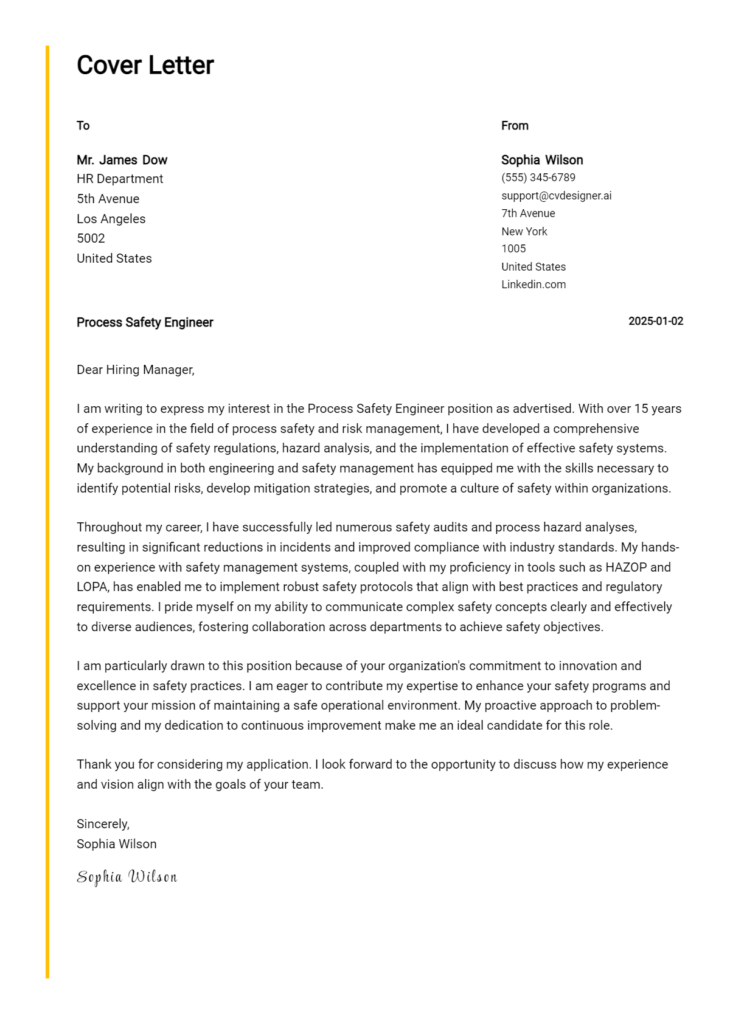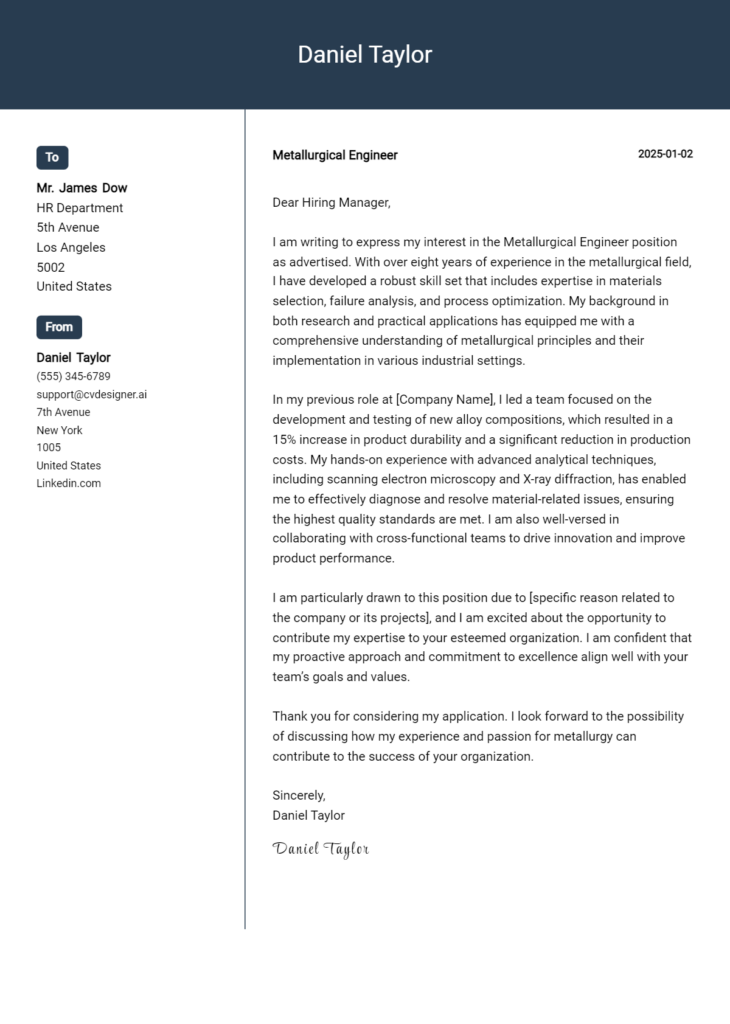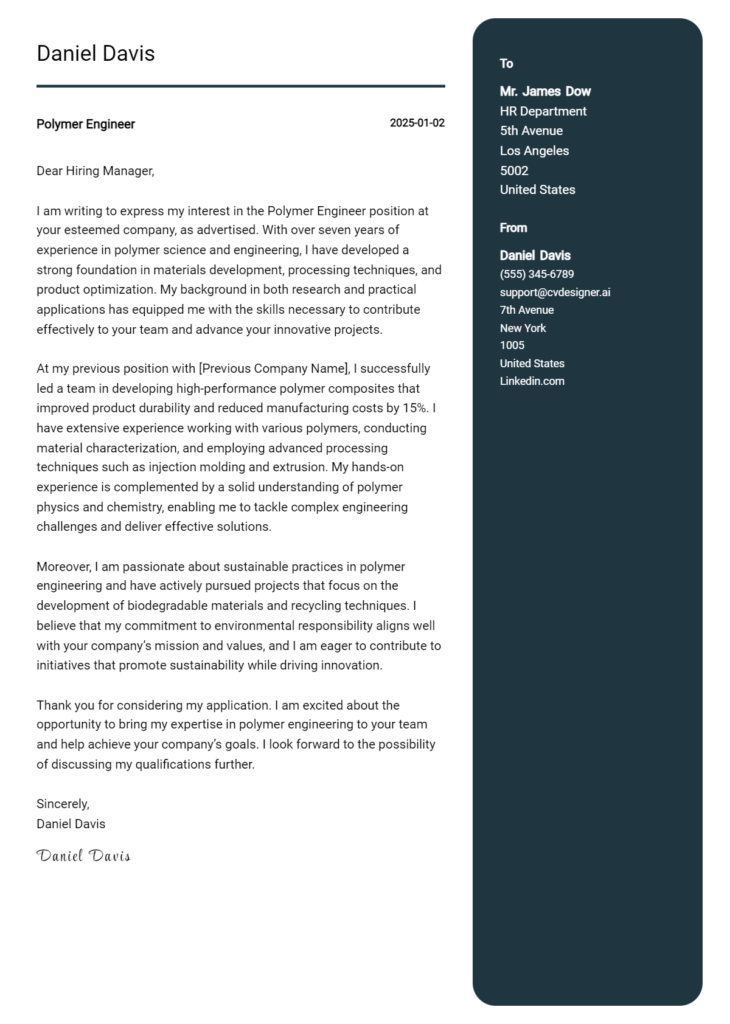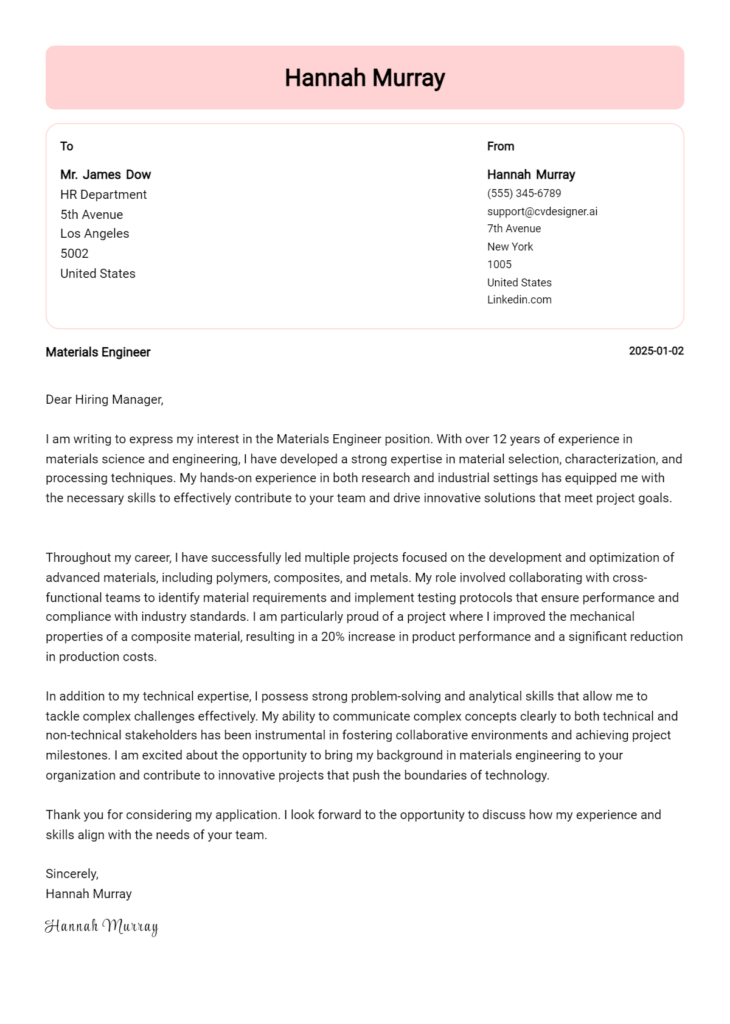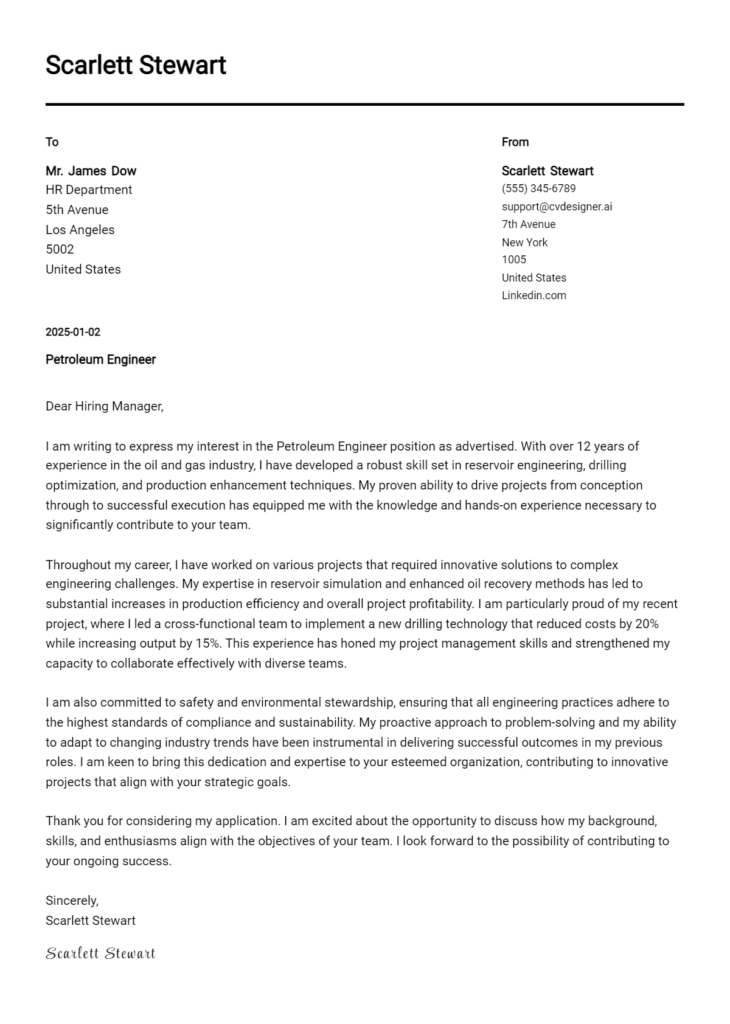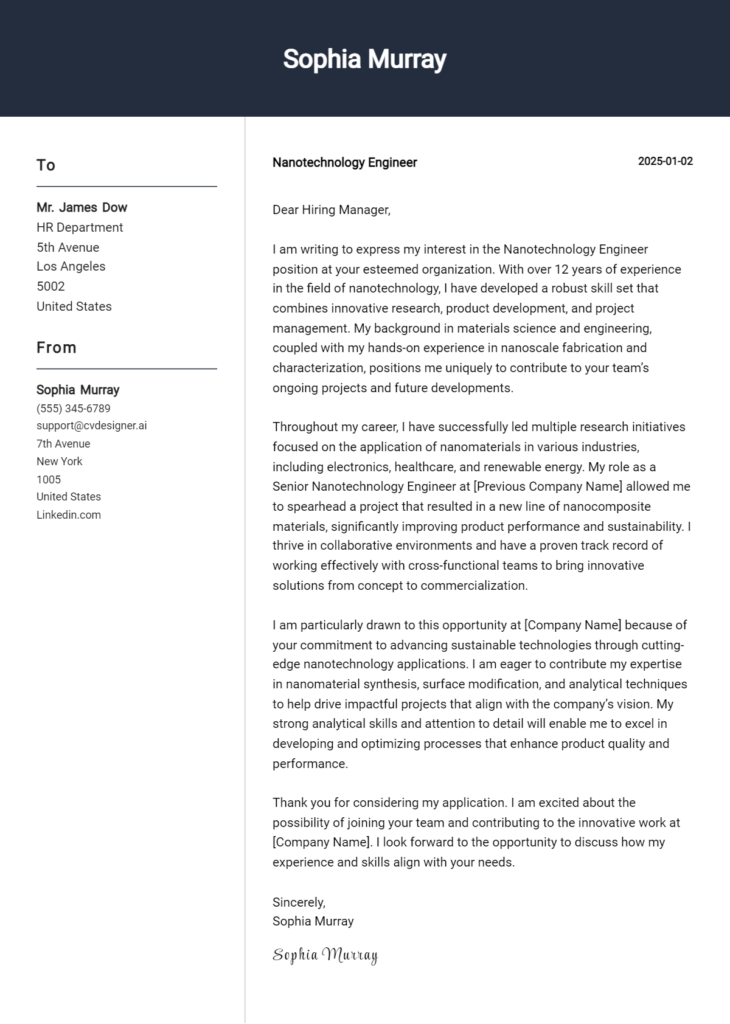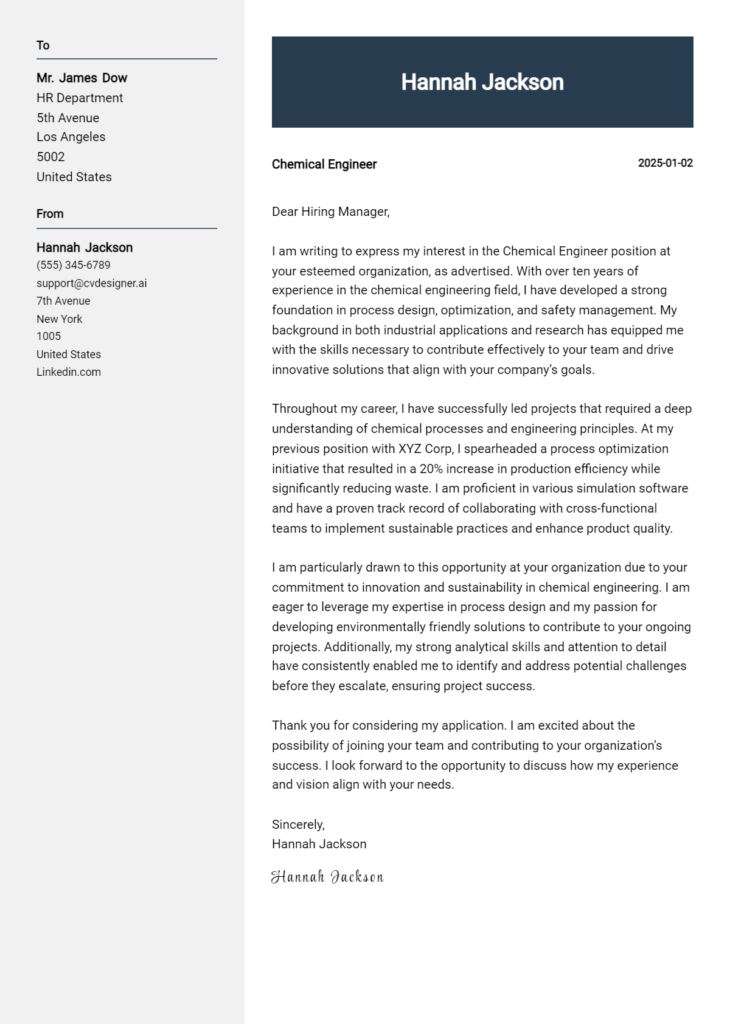Catalysis Engineer Cover Letter Examples
Explore additional Catalysis Engineer cover letter samples and guides and see what works for your level of experience or role.
How to Format a Catalysis Engineer Cover Letter
Crafting an effective cover letter is essential for a Catalysis Engineer, as it serves as your first opportunity to make a lasting impression on potential employers. The way you format and present your qualifications can significantly influence the perception of your expertise and problem-solving abilities. A well-structured cover letter not only demonstrates your technical knowledge but also reflects your meticulousness and commitment to the field of catalysis.
In this guide, we will outline how to format your cover letter, providing you with engineering-specific examples to help you create a compelling document.
We'll focus on the essential components of a professional cover letter, including:
- Cover Letter Header
- Cover Letter Greeting
- Cover Letter Introduction
- Cover Letter Body
- Cover Letter Closing
Each section is crucial in showcasing your qualifications and professionalism. Let’s break down each part and explain how to make your Catalysis Engineer cover letter stand out.
The Importance of a Cover Letter Header for a Catalysis Engineer
A well-structured cover letter header is crucial for a Catalysis Engineer as it establishes professionalism and provides essential information at a glance. The header typically includes your contact information, the date, and the recipient's details, ensuring clarity in communication. A clear and professional header sets the tone for the rest of the cover letter, demonstrating your attention to detail and organizational skills, which are vital in engineering roles.
Here’s how to format a strong and a weak cover letter header:
Strong Example
Jane Doe 123 Catalyst Lane Chemistry City, CA 12345 janedoe@email.com (123) 456-7890 October 15, 2023 Dr. John Smith Hiring Manager Innovative Catalysis Solutions 456 Innovation Road Tech Town, CA 67890
Weak Example
jane doe 123 catalyst lane october 15, 2023 Dr. smith Innovative Catalysis Solutions
The Importance of a Strong Cover Letter Greeting for a Catalysis Engineer
The greeting of a cover letter plays a crucial role in setting the tone for the rest of the document. It serves as the first point of contact between you and the hiring manager, and a well-crafted greeting demonstrates professionalism and a personal touch. By addressing the hiring manager directly, you show that you value their time and have taken the effort to research who they are, which can make a significant difference in a competitive job market. To avoid generic greetings that can make your application feel impersonal, take the time to find out the recipient's name, if possible. This small effort can help you stand out and create a more engaging introduction.
Here are examples of strong and weak greetings for a Catalysis Engineer cover letter:
Strong Greeting Example
Dear Dr. Smith,
Weak Greeting Example
To Whom It May Concern,
The Importance of a Strong Cover Letter Introduction for a Catalysis Engineer
A well-crafted cover letter introduction is crucial for a Catalysis Engineer as it sets the tone for the entire application and serves as the first impression on the hiring manager. This opening paragraph needs to capture attention, express genuine interest in the role, and briefly highlight key skills or achievements relevant to the position. A strong introduction can differentiate a candidate from others, showcasing their unique qualifications and enthusiasm for contributing to the company's success. Below are examples of strong and weak introductions for a cover letter tailored for a Catalysis Engineer role.
Strong Example
Dear [Hiring Manager's Name], As a passionate Catalysis Engineer with over five years of experience in developing innovative catalytic processes for sustainable energy solutions, I am excited to apply for the Catalysis Engineer position at [Company Name]. My recent project, which resulted in a 30% increase in catalyst efficiency, aligns perfectly with your commitment to advancing green technology. I am eager to bring my expertise in reaction kinetics and materials science to your team and contribute to groundbreaking developments in the field.
Weak Example
Dear [Hiring Manager's Name], I am writing to apply for the Catalysis Engineer position. I have a degree in chemical engineering and some experience with catalysts. I think this job sounds interesting, and I want to work at [Company Name].
Purpose of the Cover Letter Body for a Catalysis Engineer
The cover letter body for a Catalysis Engineer serves as a critical platform for candidates to effectively communicate their unique qualifications and the specific value they can bring to a potential employer. Within this section, the candidate has the opportunity to highlight their technical expertise, relevant experiences, and significant accomplishments—such as successful projects they have led or participated in, which demonstrate their ability to innovate and solve complex problems in catalysis. Providing concrete examples, such as the development of a new catalytic process that improved yield or efficiency, can significantly strengthen the candidate's case, making them a compelling choice for the role.
Strong Example
As a Catalysis Engineer with over five years of experience at XYZ Corporation, I successfully led a project that developed a novel heterogeneous catalyst for the selective oxidation of ethanol to acetaldehyde. This project not only achieved an unprecedented conversion rate of 95% but also reduced operational costs by 30%, showcasing my ability to drive innovation while aligning with company objectives. My hands-on experience in reaction engineering, coupled with my proficiency in computational catalysis, has equipped me to contribute effectively to your team and enhance your research and development efforts in sustainable catalysis.
Weak Example
I have worked as a Catalysis Engineer for a few years. I have done some projects related to catalysts. I think I would do well at your company because I know a bit about catalysis. I am looking for a new job and I hope you will consider my application.
Importance of the Cover Letter Closing for a Catalysis Engineer
The closing paragraph of a cover letter is crucial as it summarizes the applicant's qualifications, reiterates their enthusiasm for the Catalysis Engineer position, and encourages the hiring manager to take the next steps, such as reviewing the resume or scheduling an interview. A strong closing leaves a positive impression and reinforces the candidate's fit for the role, while a weak closing may fail to convey eagerness or omit essential actions for follow-up.
Strong Example
Thank you for considering my application for the Catalysis Engineer position. With my extensive experience in catalyst development and a proven track record of optimizing reaction conditions, I am excited about the opportunity to contribute to your team. I am particularly drawn to your company's commitment to sustainable practices and innovation in catalysis. I look forward to the possibility of discussing my application in more detail and am eager to contribute to your projects. Please feel free to contact me to schedule an interview at your earliest convenience.
Weak Example
Thanks for reading my cover letter. I hope you like my resume and consider me for the job. Please let me know what you think.
These tips will assist candidates in crafting an effective cover letter for a Catalysis Engineer position. A well-structured cover letter is crucial for highlighting your technical skills, problem-solving abilities, knowledge of the software development life cycle (SDLC), teamwork attributes, and a genuine passion for continuous learning. By effectively communicating these elements, you increase your chances of standing out to potential employers in the competitive field of catalysis engineering.
Tips for Writing an Effective Cover Letter for Catalysis Engineer
Showcase Technical Skills
Clearly outline your technical skills that are relevant to catalysis engineering. Mention specific techniques or methodologies you have experience with, such as heterogeneous catalysis, catalyst synthesis, or characterization methods. Providing concrete examples of your work can demonstrate your proficiency and make you a strong candidate.Highlight Problem-Solving Abilities
Employers look for engineers who can tackle complex problems. Include examples of challenges you've faced in past projects and how you effectively resolved them. This could involve optimizing a reaction process or troubleshooting catalyst performance. By showcasing your analytical thinking, you will demonstrate your value as a problem-solver in the field.Demonstrate SDLC Knowledge
Understanding the software development life cycle can be advantageous in many engineering roles. If you have experience working with simulation software or project management tools, be sure to mention it. Describe how you have applied this knowledge in your previous roles, especially in relation to catalysis research or development.Emphasize Teamwork and Collaboration
Catalysis projects often require collaboration across multidisciplinary teams. Highlight your experience working in a team setting, focusing on how you contributed to group success. Provide examples of how you communicated effectively with colleagues from different backgrounds, as teamwork is essential in achieving project goals.Express a Passion for Continuous Learning
The field of catalysis is constantly evolving, and a commitment to ongoing education is vital. Mention any recent courses, certifications, or workshops you’ve attended that relate to catalysis or engineering principles. This shows potential employers that you are proactive about keeping your skills current and are enthusiastic about advancing your knowledge.
For those looking for more structured guidance, consider using cover letter templates or a cover letter builder to create a professional and tailored cover letter that effectively presents your qualifications and enthusiasm for the Catalysis Engineer role.
Common Mistakes to Avoid in a Catalysis Engineer Cover Letter
Crafting a compelling cover letter is essential for landing a position as a Catalysis Engineer. Avoiding common mistakes can significantly enhance your chances of making a positive impression on employers. Here are some frequent pitfalls to steer clear of:
Generic Content: Failing to tailor your cover letter to the specific job can make it seem impersonal. Instead, research the company and position, and incorporate relevant details. Consider reviewing cover letter examples for inspiration.
Neglecting Formatting: Poor formatting can detract from your message. Use a clear and professional layout. For guidance on how to structure your content effectively, check out our tips on cover letter format.
Overly Technical Language: While technical knowledge is important, excessive jargon can alienate the reader. Strive for a balance between showcasing your expertise and maintaining readability.
Lack of Specific Achievements: Merely listing responsibilities from past roles without quantifiable accomplishments can weaken your application. Highlight specific projects or results to demonstrate your impact.
Ignoring the Job Description: Failing to align your skills with the requirements outlined in the job description can leave employers questioning your fit. Use keywords from the posting to strengthen your case.
Repetition of Your Resume: Your cover letter should complement your resume, not repeat it. Focus on providing context for your experiences and explaining why you are passionate about the role.
Spelling and Grammar Errors: Simple mistakes can undermine your professionalism. Always proofread your letter multiple times or ask someone else to review it before submission.
By being mindful of these common mistakes and taking steps to avoid them, you can create a strong cover letter that captures the attention of hiring managers in the field of catalysis engineering.
Cover Letter FAQs for Catalysis Engineer
What should I include in my cover letter as a Catalysis Engineer?
In your cover letter, you should include your relevant educational background, such as a degree in chemical engineering or a related field, along with any specialized training in catalysis or reaction engineering. Highlight your technical skills, such as experience with catalyst design, characterization techniques, and reaction kinetics. It’s also beneficial to mention specific projects or research that demonstrate your expertise and problem-solving abilities. Tailor your cover letter to align with the job description, showcasing how your skills meet the employer's needs. Lastly, express your enthusiasm for the role and the company, indicating why you are particularly interested in their work in catalysis.
How do I demonstrate my experience in catalysis effectively?
To effectively demonstrate your experience in catalysis, focus on specific projects or roles you've held that showcase your skills. Use quantifiable results where possible. For example, mention any improvements in catalyst efficiency you achieved or any innovations you contributed to that led to process optimization. Describe your involvement in multi-disciplinary teams and how you used your expertise to solve complex problems. Including any publications or presentations related to your work in catalysis can further establish your credibility. Additionally, don’t forget to tie your experiences back to the requirements of the job you are applying for, illustrating how your past roles have prepared you for this new opportunity.
Should I address specific achievements in my cover letter?
Yes, addressing specific achievements in your cover letter is highly recommended. Employers appreciate concrete examples that illustrate your skills and contributions. For instance, you might describe a successful project where you developed a new catalyst that increased yield by a certain percentage or reduced reaction time. Including data or metrics can significantly enhance your credibility and demonstrate your impact in previous roles. Additionally, discussing challenges you faced and how you overcame them shows problem-solving capabilities. Make sure to relate these achievements to the prospective employer’s needs, providing a clear narrative of how your past successes can translate into value for their organization.
How should I format my cover letter for a Catalysis Engineer position?
When formatting your cover letter for a Catalysis Engineer position, maintain a professional and clean layout. Start with your contact information at the top, followed by the date and the employer’s contact information. Use a standard business letter format with a formal greeting, such as "Dear [Hiring Manager’s Name]." Use clear and concise paragraphs, ideally no more than three to four, to ensure readability. Choose a professional font, such as Arial or Times New Roman, and keep the font size between 10 and 12 points. Leave adequate white space to make the document visually appealing. Finally, conclude with a professional sign-off, such as "Sincerely," followed by your name.
Build your Cover Letter in minutes
Use an AI-powered cover letter builder and have your letter done in 5 minutes. Just select your template and our software will guide you through the process.

